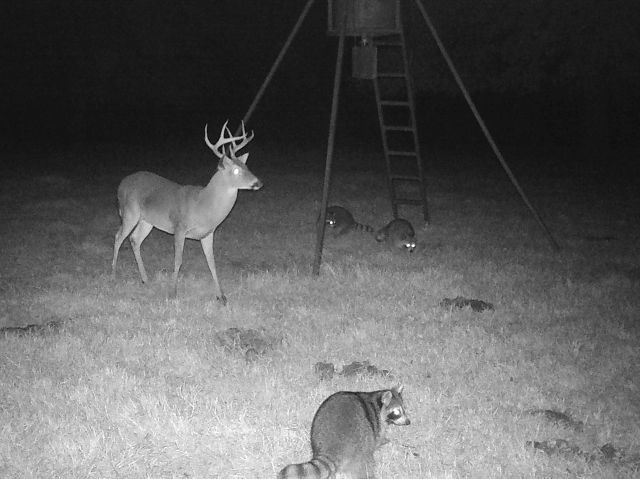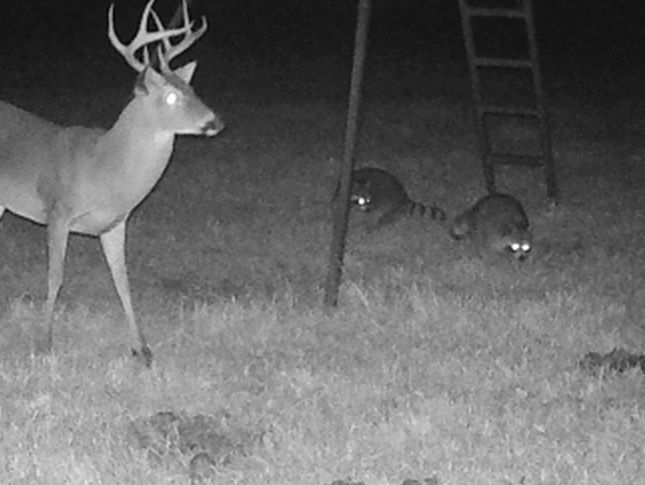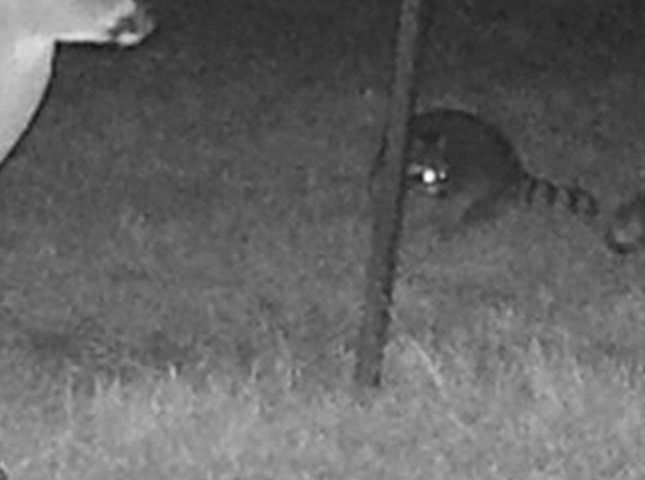New to night hunting so I have no idea what I should be looking for in a thermal scope. For instance, I saw Todd's video on hog hunting guns where he explained that as you increase the scope's magnification you reduce visual resolution. Can you give me a crash course in Thermal scopes so I have a good understanding what to look for, what is old technology, and what is recent and developing options? Thanks.
You are using an out of date browser. It may not display this or other websites correctly.
You should upgrade or use an alternative browser.
You should upgrade or use an alternative browser.
Need a Thermal Scope education
- Thread starter Whosure
- Start date
When it comes to image quality, these factors generally apply.
1. More native magnification is better than less native magnification. Yes, it comes with reduced FOV, but it also means you can shoot more accurately at distance. For most folks 2.5-3x seems to be a sweet spot for native magnification of not being too much for hunting fairly close, but helpful enough that you can zoom a bit and shoot well at 200-300 yards.
2. Bigger lens is better than a smaller lens.
3. Higher resolution better than lower resolution
4. Smaller micron size is better than larger micron size. This seems to allow makers to get a better image out of a smaller lens which translates in to a bit of cost savings as lenses often account for a large portion of the scope's cost.
Remember, these all work together to produce image quality.
Increasing native magnification does not decrease resolution, but it does decrease FOV, which isn't necessarily a bad thing unless you have too much magnification up close. On a particular scope, zooming does reduce resolution. Doubling the zoom quarters the resolution. On many scopes, the highest level of zoom is often borderline usable.
Most "old" technology includes the 384 and 320 resolution scopes, though they may be repackaged with upgraded new firmware and features. 640x480 or 640x512 resolution is the best you can get right now on the civilian market and it isn't particularly new technology either.
I am not sure what you are asking about relative to "developing options" but I would personally stay away from "developing options" unless you have a deep pocketbook and an ability to readily handle buyer's remorse. Don't be the first buyer of a newly introduced scope. Several folks have come away unhappy with buying the newest thing offered and then came to realize the scope still had "development problems" and they they just shelled out a lot of money to beta test the scope. I would suggest buying something that is tried and true versus the newest thing to come out.
1. More native magnification is better than less native magnification. Yes, it comes with reduced FOV, but it also means you can shoot more accurately at distance. For most folks 2.5-3x seems to be a sweet spot for native magnification of not being too much for hunting fairly close, but helpful enough that you can zoom a bit and shoot well at 200-300 yards.
2. Bigger lens is better than a smaller lens.
3. Higher resolution better than lower resolution
4. Smaller micron size is better than larger micron size. This seems to allow makers to get a better image out of a smaller lens which translates in to a bit of cost savings as lenses often account for a large portion of the scope's cost.
Remember, these all work together to produce image quality.
Increasing native magnification does not decrease resolution, but it does decrease FOV, which isn't necessarily a bad thing unless you have too much magnification up close. On a particular scope, zooming does reduce resolution. Doubling the zoom quarters the resolution. On many scopes, the highest level of zoom is often borderline usable.
Most "old" technology includes the 384 and 320 resolution scopes, though they may be repackaged with upgraded new firmware and features. 640x480 or 640x512 resolution is the best you can get right now on the civilian market and it isn't particularly new technology either.
I am not sure what you are asking about relative to "developing options" but I would personally stay away from "developing options" unless you have a deep pocketbook and an ability to readily handle buyer's remorse. Don't be the first buyer of a newly introduced scope. Several folks have come away unhappy with buying the newest thing offered and then came to realize the scope still had "development problems" and they they just shelled out a lot of money to beta test the scope. I would suggest buying something that is tried and true versus the newest thing to come out.
Brian,
Thanks for laying out the ins and outs of thermal scopes. It was very informative and give me an idea what to look at to compare scopes on the web sites. As for the Developing technologies, I was meaning something along the lines of manufacturers or working to better x or bring option y to market. How hard is it to get used to having the scope's rubber boot seated on your face as you shoot?
Thanks for laying out the ins and outs of thermal scopes. It was very informative and give me an idea what to look at to compare scopes on the web sites. As for the Developing technologies, I was meaning something along the lines of manufacturers or working to better x or bring option y to market. How hard is it to get used to having the scope's rubber boot seated on your face as you shoot?
Here's another way of looking at how thermal zooms work. They take the native resolution as illustrated by this game camera pic with no zoom.

the native resolution is always going to look the smoothest and be the most detailed.
when you zoom in, you are in most cases doubling the zoom (2x digital zoom) and you get the following

the pic remains the same size and the animals do get bigger, but without the added detail that you would get with an optical zoom. and as you zoom in farther...

the image begins to really break down. This was illustrated using a pic from a game camera, a thermal image will break down at the same ratio as this but isn't as sharp to begin with that that's why so many animals look like a glowing jelly bean at high digital zoom.

the native resolution is always going to look the smoothest and be the most detailed.
when you zoom in, you are in most cases doubling the zoom (2x digital zoom) and you get the following

the pic remains the same size and the animals do get bigger, but without the added detail that you would get with an optical zoom. and as you zoom in farther...

the image begins to really break down. This was illustrated using a pic from a game camera, a thermal image will break down at the same ratio as this but isn't as sharp to begin with that that's why so many animals look like a glowing jelly bean at high digital zoom.
The downside is that you will light up your face, which may or may not be an issue depending on where, when, and what you are hunting.
For scopes like the Trijicons, you can get an amber lens cover that will greatly reduce the light signature if you don't like the rubber eyecup.
Amber Filter Cover Assembly | AN/PVS-14 and F5050
Or you can go with a Bulter Creek 16 EYE 1.66" eye cap which will keep the light from shining out all the time, but you will still have your face lit up.
For scopes like the Trijicons, you can get an amber lens cover that will greatly reduce the light signature if you don't like the rubber eyecup.
Amber Filter Cover Assembly | AN/PVS-14 and F5050
Or you can go with a Bulter Creek 16 EYE 1.66" eye cap which will keep the light from shining out all the time, but you will still have your face lit up.
wigwamitus
LSB Active Member
Right now there are two main manufacturers in the civilian thermal space:
Pulsar - these are the "working man's scopes" (trying to avoid saying "low cost - or low end" ) ... I've had four of them and still have one and their strength is "bang for the buck" ... best "value for the money.
) ... I've had four of them and still have one and their strength is "bang for the buck" ... best "value for the money.
You can still get the older Apex models, both the 38mm and 50mm for around $2500 to $2800 and they definitely get the job done.
The newer Trails have 384 and 640 resolutions and also have 38mm and 50mm versions of each ... The "high end" are the Trail XP 38mm and 50mm. Those are the 640s. They run around $4,200 to $4,500 ....
And all of these get the job done for hunting.
Trijicon - these are the "high end" (in the civilian market). They use the BAE OASYS 12um cores which are amazing critters ...
There are two housing styles, the "joy stick" and the "turrets". Each housing style has three focal lengths
The 19mm, the 35mm and the 60mm.
The joystick housings are lighter and smaller and for dual use as spotters and weapons mounted the 19mm and 35mm joysticks are more flexible. The 60mm joystick does not support weapons mounting.
The turret housings are heavier and some think more robust. Trijicon says they have a second lens in front of the lens to protect the main lens. Some also think the turrets are easier to learn than the joystick. I've had both and unfortunately I had the turrets first, so I like them better. But having used the joystick for several months, I think once you learn it, there is no real difference in the field.
These run from about $5,500 to $8,500 depending on the focal length. The joystick housings have a manual focus, the turret housings do not. For me this is a slight advantage to the joysticks, especially for the 60mm version ... the long distance spotter. Though I will say the fixed focus in the turret units works well and there is digital focus to help sharpen the image.
Right now, I'd consider those to be the main choices. There are many others.
Most of the regulars on here have or have had Armasights as well. I've had five Armasight thermals myself. They also get the job done. My concern with Armsights right now isn't the widgets, it is the business direction FLIR is taking after the merger, which seems to be a bigger unknown than in the case of Trijicon after the merger with IRD. So I've sold my Armasight Thermals and I'm waiting awhile to see what happens with FLIR and the Armasight Thermal line. We've heard a lot about the new boson line. We've seen boson q-14s and boson zeuses and bosun apollos ... but not really ... no dealers have them to my knowledge, we've just heard about them. The one release is the 19mm weapons sight with a fixed focus. Sort of a teaser. So I'm still on the fence with Armasight in the new world. Whereas I was all in 2-3 years ago.
ATN - I've had three ATN devices, 2 of them thermals. Two of the devices were poor quality. The third an ODIN thermal monocular I still have and like and use a lot. The Thor HD Unit I had was an unfinished thing. I do not recommend the ATN Thermal scopes.
Those 4 have been the main "in terms of quantity" thermal manufacturers for the past 4 years in the civilian world.
There are many smaller players and there are also the military thermals. They are generally 2-4 times more expensive, so most people don't have many of them. And, in many ways are not 2-4 times better in terms of what a hunter needs. I have a military clipon and it has a BAE OASYS core, but it is a 17um core and the Trijicons are 12um. The military units do have advantages, but unless you need those advantages your money could be better spent.
==
So to me the simple answer, is if you are primarily cash constrained but want something that works ... I would get the best pulsar I could afford and go with that. On the other hand, if you are more enamored with "the best image" than you are with your cash ... then jump up to the Trijicons. They will help you PID smaller critters faster at greater distances.
Alternatively, you can wait and see whats showing at SHOT in January. But be forewarned. Many years, the items shown at SHOT, do not appear on the market for 9+ months. There have even been items shown at SHOT that NEVER appeared (who here is old enough to remember the WASP ).
).
Pulsar - these are the "working man's scopes" (trying to avoid saying "low cost - or low end"
You can still get the older Apex models, both the 38mm and 50mm for around $2500 to $2800 and they definitely get the job done.
The newer Trails have 384 and 640 resolutions and also have 38mm and 50mm versions of each ... The "high end" are the Trail XP 38mm and 50mm. Those are the 640s. They run around $4,200 to $4,500 ....
And all of these get the job done for hunting.
Trijicon - these are the "high end" (in the civilian market). They use the BAE OASYS 12um cores which are amazing critters ...
There are two housing styles, the "joy stick" and the "turrets". Each housing style has three focal lengths
The 19mm, the 35mm and the 60mm.
The joystick housings are lighter and smaller and for dual use as spotters and weapons mounted the 19mm and 35mm joysticks are more flexible. The 60mm joystick does not support weapons mounting.
The turret housings are heavier and some think more robust. Trijicon says they have a second lens in front of the lens to protect the main lens. Some also think the turrets are easier to learn than the joystick. I've had both and unfortunately I had the turrets first, so I like them better. But having used the joystick for several months, I think once you learn it, there is no real difference in the field.
These run from about $5,500 to $8,500 depending on the focal length. The joystick housings have a manual focus, the turret housings do not. For me this is a slight advantage to the joysticks, especially for the 60mm version ... the long distance spotter. Though I will say the fixed focus in the turret units works well and there is digital focus to help sharpen the image.
Right now, I'd consider those to be the main choices. There are many others.
Most of the regulars on here have or have had Armasights as well. I've had five Armasight thermals myself. They also get the job done. My concern with Armsights right now isn't the widgets, it is the business direction FLIR is taking after the merger, which seems to be a bigger unknown than in the case of Trijicon after the merger with IRD. So I've sold my Armasight Thermals and I'm waiting awhile to see what happens with FLIR and the Armasight Thermal line. We've heard a lot about the new boson line. We've seen boson q-14s and boson zeuses and bosun apollos ... but not really ... no dealers have them to my knowledge, we've just heard about them. The one release is the 19mm weapons sight with a fixed focus. Sort of a teaser. So I'm still on the fence with Armasight in the new world. Whereas I was all in 2-3 years ago.
ATN - I've had three ATN devices, 2 of them thermals. Two of the devices were poor quality. The third an ODIN thermal monocular I still have and like and use a lot. The Thor HD Unit I had was an unfinished thing. I do not recommend the ATN Thermal scopes.
Those 4 have been the main "in terms of quantity" thermal manufacturers for the past 4 years in the civilian world.
There are many smaller players and there are also the military thermals. They are generally 2-4 times more expensive, so most people don't have many of them. And, in many ways are not 2-4 times better in terms of what a hunter needs. I have a military clipon and it has a BAE OASYS core, but it is a 17um core and the Trijicons are 12um. The military units do have advantages, but unless you need those advantages your money could be better spent.
==
So to me the simple answer, is if you are primarily cash constrained but want something that works ... I would get the best pulsar I could afford and go with that. On the other hand, if you are more enamored with "the best image" than you are with your cash ... then jump up to the Trijicons. They will help you PID smaller critters faster at greater distances.
Alternatively, you can wait and see whats showing at SHOT in January. But be forewarned. Many years, the items shown at SHOT, do not appear on the market for 9+ months. There have even been items shown at SHOT that NEVER appeared (who here is old enough to remember the WASP
KJQ6945
LSB Member
You've heard from the smart people, that truly know what they are talking about.
Time for the dumbass to speak.
I wish I had found this place before I bought my thermal. I did some research, but not near enough.
I bought an ATN, yes I said it. I feel a since of relief admitting it.
Would I do it again? Probably not.
I had never even looked through a thermal scope until I got mine. I wanted to go on a hog hunt, so I bought one.
I have since looked through Rookies Trijicon MKIII, and the difference is significant.
I have two big complaints with my ATN. One, I'll blame ATN for, the second is on me.
Number 1.) it's just to complicated.
It has to many features built in, and I'm not a computer guy. Basically, it's smarter than I am. That's on ATN.
Number 2.) I bought to much scope.
Mine is 9-36x100. I had decided on the 4.5 power unit, but then I found this 9 power for the same money. I'm a guy, hell, bigger is better, right? Not always.
With a minimum magnification of 9 times, it really messes with my depth perception. I can't judge distance.
My hog hunt in September with the scope went great. It was very accurate, I'm shooting hogs in the ear at 150 yards, only complaint was trying to judge distance on a field I hadn't seen in daylight.
Fast forward to November, and suddenly, I can't hit a coyote at 50 yards. I reZeroed it several times, and every time, it was off about a foot. WTF?
Eventually I factory reset it, and erased all the profiles. That was the issue. A new profile had been created as profile one, and that's what it reverted to every time I turned it on. Re zeroing it didn't change it until I deleted the previous profiles saved in the memory. I missed a few coyotes because every time I turned it on, i was 12" left at 50 yards. To complicated!
Let me explain the second issue, to much magnification.
I begged Rookie to take me coyote hunting so I could figure out how to do it. I had never been, but hey, I've got a thermal scope, so now's the time.
The first time we had one come running into us, I shot to soon, missed due to the above zero problem, and neither of us were happy.
I shot to soon because of the magnification issue. I'm watching this yote running at us, thinking, ok, he's gonna shoot any second now. It keeps getting closer. He'll shoot first. I'm counting the whiskers on this thing, thinking, I hope he shoots it quick. I wonder what a coyote bite feels like?
I pulled the trigger in self defense, and that's my story. Turns out, it was a little farther than I thought.
Sorry Rookie.
Time for the dumbass to speak.
I wish I had found this place before I bought my thermal. I did some research, but not near enough.
I bought an ATN, yes I said it. I feel a since of relief admitting it.
Would I do it again? Probably not.
I had never even looked through a thermal scope until I got mine. I wanted to go on a hog hunt, so I bought one.
I have since looked through Rookies Trijicon MKIII, and the difference is significant.
I have two big complaints with my ATN. One, I'll blame ATN for, the second is on me.
Number 1.) it's just to complicated.
It has to many features built in, and I'm not a computer guy. Basically, it's smarter than I am. That's on ATN.
Number 2.) I bought to much scope.
Mine is 9-36x100. I had decided on the 4.5 power unit, but then I found this 9 power for the same money. I'm a guy, hell, bigger is better, right? Not always.
With a minimum magnification of 9 times, it really messes with my depth perception. I can't judge distance.
My hog hunt in September with the scope went great. It was very accurate, I'm shooting hogs in the ear at 150 yards, only complaint was trying to judge distance on a field I hadn't seen in daylight.
Fast forward to November, and suddenly, I can't hit a coyote at 50 yards. I reZeroed it several times, and every time, it was off about a foot. WTF?
Eventually I factory reset it, and erased all the profiles. That was the issue. A new profile had been created as profile one, and that's what it reverted to every time I turned it on. Re zeroing it didn't change it until I deleted the previous profiles saved in the memory. I missed a few coyotes because every time I turned it on, i was 12" left at 50 yards. To complicated!
Let me explain the second issue, to much magnification.
I begged Rookie to take me coyote hunting so I could figure out how to do it. I had never been, but hey, I've got a thermal scope, so now's the time.
The first time we had one come running into us, I shot to soon, missed due to the above zero problem, and neither of us were happy.
I shot to soon because of the magnification issue. I'm watching this yote running at us, thinking, ok, he's gonna shoot any second now. It keeps getting closer. He'll shoot first. I'm counting the whiskers on this thing, thinking, I hope he shoots it quick. I wonder what a coyote bite feels like?
I pulled the trigger in self defense, and that's my story. Turns out, it was a little farther than I thought.
Sorry Rookie.
Don’t mean to be a stick in the mud but all of this has been discussed in great detail. If you use the search bar or just spend some time and do a LOT of reading on this site alone. there is more than enough info, plus all the videos on the UTube. Just the informative videos from TxLawman with all of his work he has done with comparing and showing how they work is and should be enough to give you brain freeze. Thermal Thermal!!
With a minimum magnification of 9 times, it really messes with my depth perception. I can't judge distance.
This isn't a magnification issue, per se, though changes in magnification can mess up people's ability to judge distance. Simply put, when it comes to range estimation, thermal scopes offer very poor depth perception and this messes with people's ability to estimate distance. It is important that if you do range estimate visually with a thermal scope, that you always do it on the same level of magnification because it is hard enough to try to estimate range from any one level of magnification and be reasonably good at it, so trying it at other levels just means more problems.
Because I get to work with multiple scopes from *******************, this is a problem I encounter frequently. If I forget which scope I am using, my concept of approximate range is invalid.
Even more problematic is that as thermal conditions deteriorate, the ability to estimate range deteriorates as well...and it wasn't ever very good in the first place.
When possible, I like to make use of landmarks that I have ranged previously, such as when I am stand hunting. For example...
Alternatively, you can wait and see whats showing at SHOT in January. But be forewarned. Many years, the items shown at SHOT, do not appear on the market for 9+ months. There have even been items shown at SHOT that NEVER appeared (who here is old enough to remember the WASP).
Excellent example.
Is ranging software common on the more economical models? Is it worth it or does it just drive up the cost of the scope?
The only option that I know of is stadiametric ranging. The idea is that you can measure a known object and it will tell you how far it is. To me it's worthless, because animals come in all shapes and sizes so the estimate is just a guess.
Pulsar had the thermal with laser range finders, but I was told our government put a stop to it.
wigwamitus
LSB Active Member
... Is ranging software common on the more economical models? Is it worth it or does it just drive up the cost of the scope?
... Pulsar had the thermal with laser range finders, but I was told our government put a stop to it.
For most hunting activities, precise ranging is not critical. Most hunting shots are under 100yds, most of the rest under 200yds and most of the rest under 300yds.
If you double zero at 50/200 yds with most cartridges, you will have less than 2 inches of elevation variation out to 200yds. If you really think you will be mostly shooting between 200yds and 300yds then move your double zero to something like 30/300. That will increase your verticial deviation in the 100-200 yds range band, maybe you will need to hold down 6 inches.
But this still isn't long distance shooting where you need to account for hundreds of inches of drop.
==
Yes there are two pulsar models with physical LRFs attached and integrated.
Pulsar Apex Thermal Weapon Sight Up to $330.02 Off — 2 models
And the new trijicons have some software support for ranging (although using the reticles for ranging is also possible).
If any of my governments have stopped sales of LRF units, I haven't heard about it. And Optics Planet is still selling those APEX with the integrated LRFs.
==
Here are pics of some of the Trijicon reticles, showing how to use them for ranging ...

wigwamitus
LSB Active Member
As to the government stopping sales ... you might be right!
I do see this blurb on NightVIsion Guys
Though "not yet available" seems miss leading. I've talked to dealers who said they were "flying off the shelves".
Midway shows them orderable but not in stock.
Pulsar Apex LRF XQ50 Thermal Rifle Scope 2.8-11.2x 42mm - MPN: PL76429
==
So then if you want a physical range finder, you just have to use a separate one.
I do see this blurb on NightVIsion Guys
Apex LRF scopes are not yet available. Pulsar is awaiting federal approval for the laser rangefinder system. No hard target is available at the moment.
Though "not yet available" seems miss leading. I've talked to dealers who said they were "flying off the shelves".
Midway shows them orderable but not in stock.
Pulsar Apex LRF XQ50 Thermal Rifle Scope 2.8-11.2x 42mm - MPN: PL76429
==
So then if you want a physical range finder, you just have to use a separate one.
As to the government stopping sales ... you might be right!
I do see this blurb on NightVIsion Guys
Though "not yet available" seems miss leading. I've talked to dealers who said they were "flying off the shelves".
Midway shows them orderable but not in stock.
Pulsar Apex LRF XQ50 Thermal Rifle Scope 2.8-11.2x 42mm - MPN: PL76429
==
So then if you want a physical range finder, you just have to use a separate one.
Yeah, I was told this by a knowledgeable member on this forum. He can chime in if he wants to, but it's up to him.

